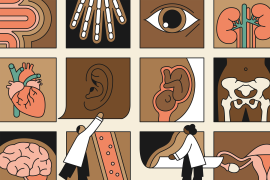Updated since original posting in October 2018.
Earlier this week, the Trump administration published its long-anticipated final “public charge” rule, a policy change carrying enormous implications for communities across the United States. The administration’s proposal would radically expand the government’s ability to deem legal immigrants who are not yet citizens as public charges — individuals considered financially dependent on the government. Medicaid, along with cash assistance, food stamps, and public housing, is the type of public benefit that can cause someone to be labeled a public charge.
The rule’s impact will fall not only on immigrants enrolled in Medicaid. It also will have detrimental effects on their citizen children, as well as on clinics, hospitals, and public health agencies in the communities where immigrant families reside.
As with the proposed rule, the final rule does not attach public-charge triggers to either the Children’s Health Insurance Program (CHIP) or the Affordable Care Act marketplace subsidies. Only the poorest immigrants who depend on Medicaid are subject to punishment — for example, denial of green card status — for using the health insurance for which they are eligible under current law.
Under previous policy, Medicaid counted as evidence of public-charge status only when it was used to pay for nursing home or other long-term institutional care. The final rule sweeps away this limited approach, meaning that almost any use of Medicaid by people subject to the public-charge restrictions — even short-term — could prevent a legal immigrant from becoming a citizen of the United States.
With limited exceptions — children under 21, pregnant and postpartum women, and formally designated refugees and asylees — anyone who uses Medicaid to help pay for virtually any nonemergency treatment could be considered a public charge if, within the 36 months preceding application for immigration or adjustment of status, the individual has received more than 12 months of coverage. But the administration undermines this seeming willingness to permit short-term coverage periods by separately making clear that immigration agents will consider any past use of a designated public benefit like Medicaid in making their public-charge determinations.
Use of Medicaid for preventive services, primary care, management of a chronic condition, or breast cancer treatment — all are examples of care that would prejudice an immigrant’s citizenship application.
Impetus for the Rule
The logic behind the rule’s treatment of Medicaid is unclear. The Trump administration states its policy goal is “self-sufficiency.” But when it comes to health insurance, practically no American — citizen or otherwise — would be insured without considerable government assistance; indeed, in 2018 the federal government spent $280 billion subsidizing employer-based benefits through the tax code.
How many employers could afford to help employees get insurance without this government assistance? How many U.S. citizens could deal with a serious illness on a cash-on-hand basis? If this is the test of self-sufficiency, few of us could pass, given that 62 percent of Americans have less than $1,000 cash on hand. To single out Medicaid for punitive treatment among all forms of health insurance suggests that the goal here is something other than self-sufficiency.
Indeed, consistent with the administration’s continuing effort to encourage Section 1115 demonstrations that impose restrictions such as Medicaid work requirements, premiums, and lock-out periods, the rule would not only make it far more difficult for poor immigrants to qualify for U.S. residency but would also significantly reduce Medicaid enrollment. The administration essentially ignored the voluminous evidence in the comment record regarding the rule’s damaging effect on Medicaid enrollment.
A Chilling Effect
The problems with the rule do not end with the individuals directly affected. Equally concerning is the chilling effect on immigrants who are exempt and thus remain fully eligible. In recent years, the government had encouraged Medicaid enrollment by eligible legal immigrants: the Migration Policy Institute estimates that more than 4 million legal U.S. residents who are not yet citizens receive Medicaid. Another 9.6 million live in families in which a member (nearly always a U.S.-born child) is enrolled in Medicaid. Millions of these citizen children could be hurt by the administration’s rule change, as fearful parents pull their still-eligible children out of Medicaid. The latest estimates put coverage losses for legal immigrants at between 2.1 million and 4.9 million.
Ample experience with past policies that restrict benefits for immigrants shows the impact of these changes extends not only to larger family groups but to the communities in which immigrants reside. Caught in the web are the clinics, hospitals, and local public health agencies on which the community at large may depend. One study found the first-year revenue impact on community health centers would be between $346 and $624 million, which translates to as many as 538,000 fewer patients, regardless of immigration status, served in a year.
The potential health and economic ramifications of the final rule are vast. Furthermore, the rule appears to steer the nation toward an immigration policy that favors the select few — precisely the type of narrowing of who is “acceptable” that this nation has long rejected. Expect a long and intense period of litigation to ensue.




